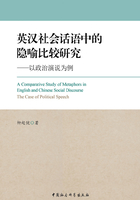
Chapter 1 Introduction
1.1 Some preliminaries
Let me just begin by reflecting on the key concept of this book metaphor. By ‘metaphor’ I mean the phenomenon whereby we talk about,potentially,understand,experience and even reason about one kind of thing in terms of another (Lakoff & Johnson,1980:5;Semino,2008:1). For example,in the linguistic expression ‘long,rugged path towards prosperity and freedom’,we can see that a nation's rising and development is talked about in terms of a long journey that involves some form of short-term suffering or struggle,which may reinforce a particular but perfectly reasonable way of thinking and even reasoning about the cause in terms of a PATH schema.
The common knowledge is that languages are dependent on human thoughts,and the processing of human thoughts is inseparable from the conceptual judgment and logical reasoning as well. To reveal the nature of language,we need to analyze and make sense of the cognitive subjects’ way of thinking through the use of their languages. Moreover,dialectical materialism theorists hold that people's social existence determines their social consciousness and that people's way of thinking is closely related to their behavioral patterns which at least include the mode of social existence,the personal experience,and the social and cultural patterns. In fact,metaphor studies mainly deal with the complex relationships between people's way of thinking and their behavioral patterns in that metaphor is pervasive in everyday life,not just in language but in thought and action,and our ordinary conceptual system,in terms of which we both think and act,is fundamentally metaphorical in nature (Lakoff & Johnson,1980:1;Xie,2007:preface). The following is an example of such a set (Lakoff & Johnson,1980:4).
Your claims are indefensible.
He attacked every weak point in my argument.
His criticisms were right on target.
I demolished his argument.
I've never won an argument with him.
You disagree? Okay,shoot!
If you use that strategy,he’ll wipe you out.
He shot down all of my arguments.
Given all these sentences,we may note that a large part of the way we speak about argument or debate in English derives from the way we speak about war. Technically,some elements in the concrete conceptual domain ‘war’ equipped with a highly organized structure get mapped onto the elements in the relatively abstract conceptual domain ‘argument’ without a systematic structure. Within CMT,an important distinction needs to be implicitly introduced between metaphorical expression,such as ‘shoot down’ and its corresponding conceptual metaphor or metaphorical concept ARGUMENT IS WAR. The metaphorical expressions in italics above that come from the language or terminology of the more concrete conceptual domain are named as linguistic metaphor[1]. The conventional patterns of concept underlying the metaphorical expressions are labeled as conceptual metaphor. The former is the specific linguistic realization of the latter. Thus,all the linguistic expressions in italics that have to do with argument and that come from the domain of war are linguistic metaphors,whereas the conceptual metaphor that these linguistic metaphors make manifest is ARGUMENT IS WAR.